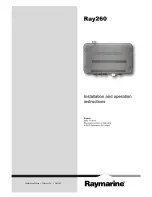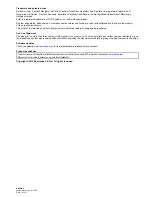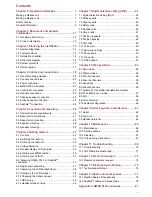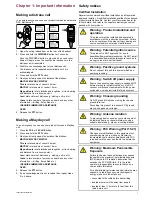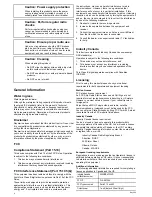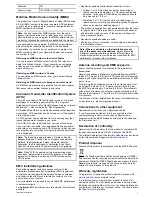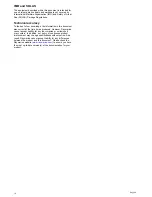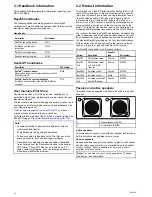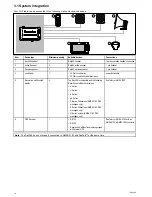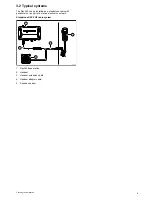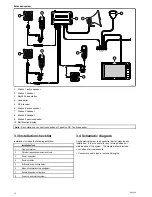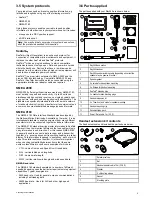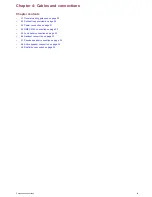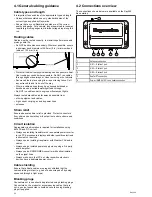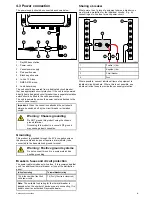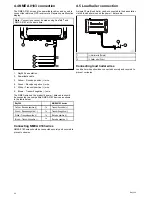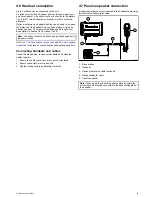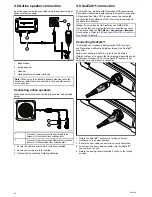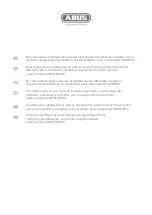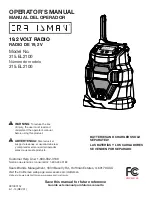
Modulation
FM
Frequency range
155.000 MHz to 165.000 MHz
Maritime Mobile Service Identity (MMSI)
This product is a class “D” Digital Selective Calling (DSC) device.
A 9 digit MMSI number is required to operate DSC equipment.
In some areas, a radio operator license is required before an
MMSI number can be issued.
Note:
You can request an MMSI number from the same
agency that issues radio or ship radio licenses in your area.
Once obtained, you can program the MMSI number into your
product by following the instruction supplied with the product.
Once obtained, you can program the MMSI number into your
product using the instructions provided in this handbook.
If regulations in your area do not permit you to program the
MMSI number yourself, your Raymarine dealer can program
the number for you.
Obtaining an MMSI number in the United States
You can request an MMSI number from the FCC when you
apply for a Station License. If your vessel does not require
a license, you may obtain an MMSI by contacting BoatUS
www.boatus.com
.
Obtaining an MMSI number in Canada
You can obtain an MMSI number from your nearest Industry
Canada Office.
Obtaining an MMSI number in Europe and rest of world
Am MMSI number should be requested from the same agency
that issues radio operator licenses in your area.
Automatic Transmitter Identification System
(ATIS)
Your product includes ATIS functionality for use on the inland
waterways of contracting governments of the
“Regional
Arrangement Concerning the Radiotelephone Service on Inland
Waterways”
— also known as the
“Basel Agreement”
.
ATIS adds data at the end of radio transmissions that identifies
your station. ATIS operation can be turned on or off as needed
via the radio’s menu.
An ATIS number can be obtained from the same agency that
issues radio operator licenses in your area.
Your ATIS ID number is derived from your vessel’s call sign.
If your call sign is suitable, your authorized Raymarine dealer
can assist you in decoding your ATIS ID number, which you can
then program into your product using the instructions provided
in this handbook.
Note:
The Basel Agreement includes: Germany, Austria,
Belgium, Bulgaria, Croatia, France, Hungary, Luxembourg,
Moldova, the Netherlands, Poland, Romania, Russian
Federation, the Slovak Republic, Switzerland, the Czech
Republic, Ukraine and the Federal Republic of Yugoslavia.
Note:
When ATIS is enabled, certain programming steps
have been implemented to protect the integrity of the Basel
agreement, including the blocking of DSC functions when
ATIS is active.
EMC installation guidelines
Raymarine equipment and accessories conform to the
appropriate Electromagnetic Compatibility (EMC) regulations,
to minimize electromagnetic interference between equipment
and minimize the effect such interference could have on the
performance of your system
Correct installation is required to ensure that EMC performance
is not compromised.
For
optimum
EMC performance we recommend that wherever
possible:
• Raymarine equipment and cables connected to it are:
– At least 1 m (3 ft) from any equipment transmitting or
cables carrying radio signals e.g. VHF radios, cables and
antennas. In the case of SSB radios, the distance should
be increased to 7 ft (2 m).
– More than 2 m (7 ft) from the path of a radar beam. A
radar beam can normally be assumed to spread 20 degrees
above and below the radiating element.
• The product is supplied from a separate battery from that used
for engine start. This is important to prevent erratic behavior
and data loss which can occur if the engine start does not
have a separate battery.
• Raymarine specified cables are used.
• Cables are not cut or extended, unless doing so is detailed in
the installation manual.
Note: Where constraints on the installation prevent
any of the above recommendations
, always ensure the
maximum possible separation between different items of
electrical equipment, to provide the best conditions for EMC
performance throughout the installation
Antenna mounting and EME exposure
Ensure that the antenna is connected to the radio before
transmission.
Raymarine declares a Maximum Permissible Exposure (MPE)
radius of 1.5 metres (4.9 ft) (per OET Bulletin 65) for this system,
assuming 25 watts output to an omnidirectional antenna of 3dBi
gain or less.
For watercraft with suitable structures, the antenna base must
be at least 3.5 metres (11.5 ft) above the main deck to meet
the MPE for persons up to 2 metres (6.6 ft) tall. For watercraft
without such structures, the antenna must be mounted so that
its base is a minimum of 1.5 metres (4.9 ft) vertically from heads
of all persons.
The antenna must be isolated from the vessel’s metalwork using
an insulated (e.g. plastic) mounting bracket.
Connections to other equipment
Requirement for ferrites on non-Raymarine cables
If your Raymarine equipment is to be connected to other
equipment using a cable not supplied by Raymarine, a
suppression ferrite MUST always be attached to the cable near
the Raymarine unit.
Declaration of conformity
Raymarine UK Ltd. declares that this product is compliant with
the essential requirements of R&TTE directive 1999/5/EC.
The original Declaration of Conformity certificate may be viewed
on the relevant product page at
www.raymarine.com
.
Product disposal
Dispose of this product in accordance with the WEEE Directive.
The Waste Electrical and Electronic Equipment (WEEE)
Directive requires the recycling of waste electrical and electronic
equipment. Whilst the WEEE Directive does not apply to some
Raymarine products, we support its policy and ask you to be
aware of how to dispose of this product.
Warranty registration
To register your Raymarine product ownership, please visit
www.raymarine.com
and register online.
It is important that you register your product to receive full
warranty benefits. Your unit package includes a bar code label
indicating the serial number of the unit. You will need this serial
number when registering your product online. You should retain
the label for future reference.
Important information
9
Summary of Contents for Ray260
Page 2: ......
Page 4: ......
Page 18: ...18 Ray260 ...
Page 30: ...30 Ray260 ...
Page 52: ...52 Ray260 ...
Page 60: ...60 Ray260 ...
Page 64: ...64 Ray260 ...
Page 68: ...68 Ray260 ...
Page 72: ...72 Ray260 ...
Page 80: ...80 Ray260 ...
Page 92: ...92 Ray260 ...
Page 93: ......
Page 94: ...www raymarine com ...

